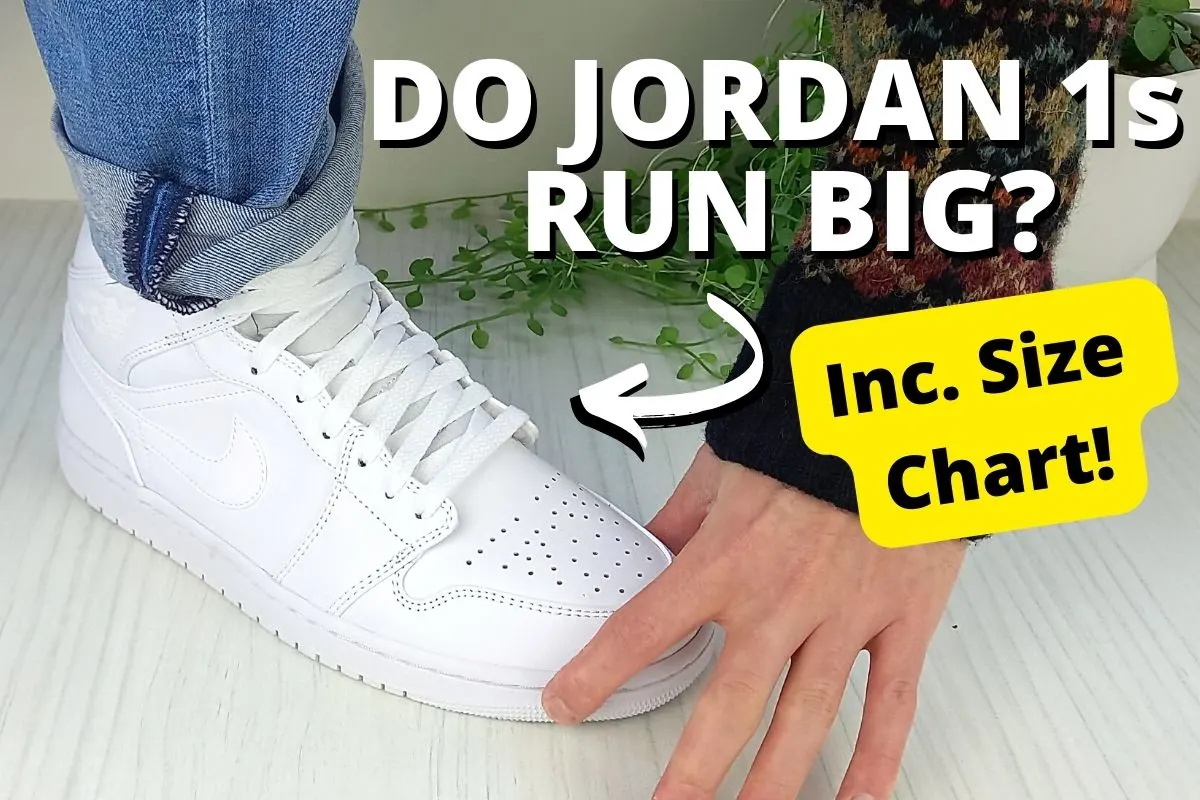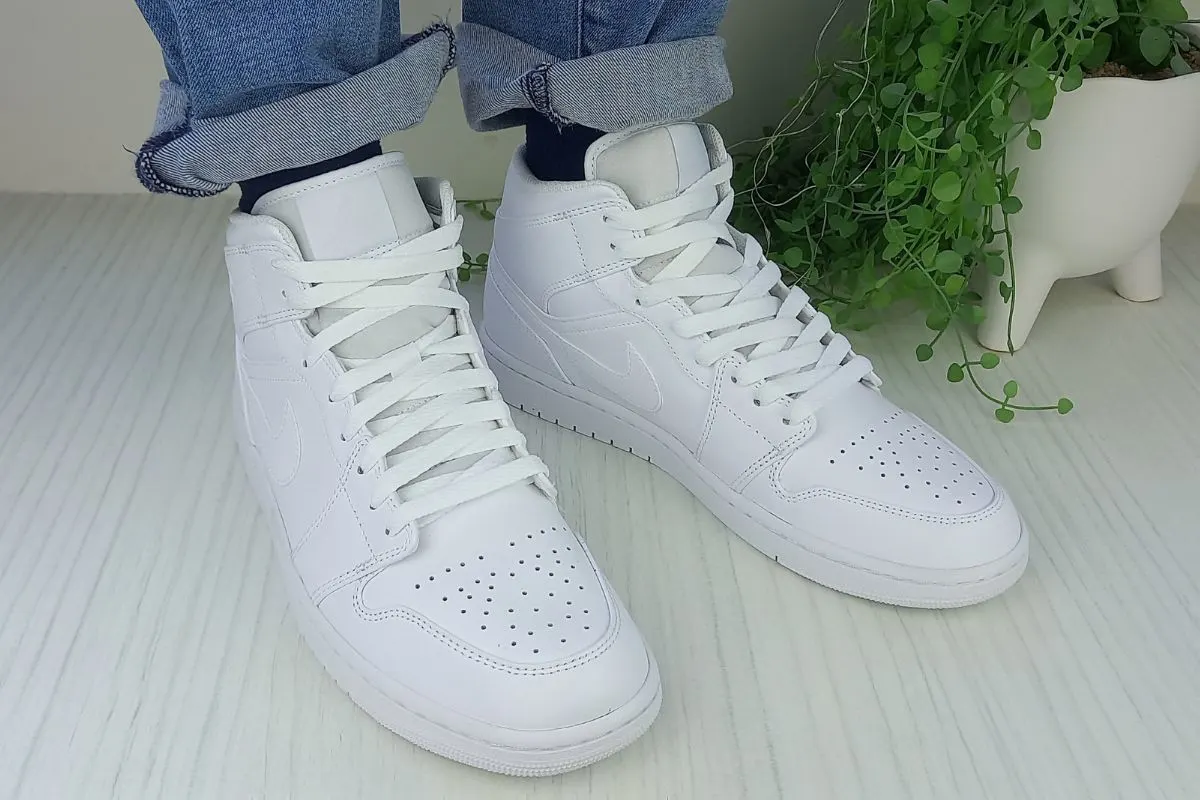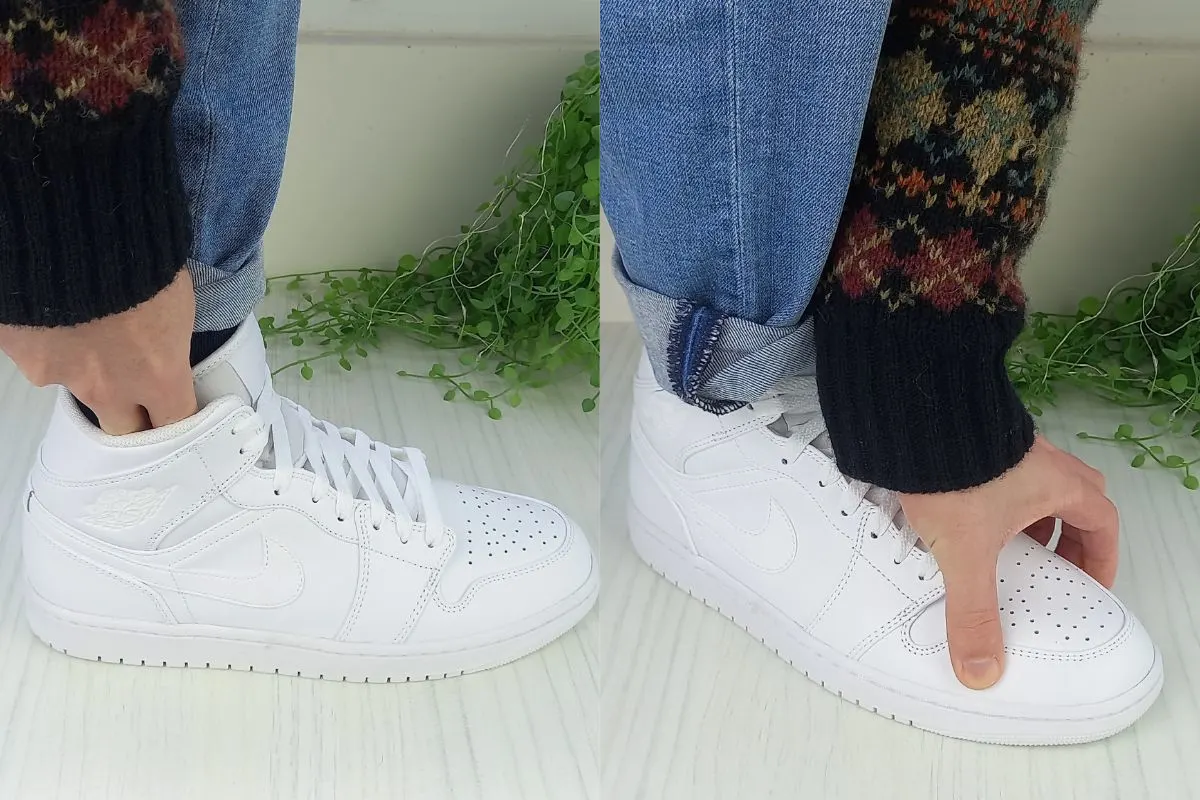As an avid shoe lover and collector, there are few things more frustrating than investing time and money in a world-class shoe only to find that the size shoe you usually bought from the brand suddenly feels too big or too small. So, before saving up for Jordan 1s, we must address a vital question “are they true to their size, or do they run big?”.

Since the 1980s, Nike has manufactured high-quality shoes on the Brannock principle without fail. As a result, if you know your shoe size and want to purchase the Jordan 1s, you’ll find that all their models over the years have been manufactured with consistency and devoid of formula changes, making them true to size.
Take a look at the current price of Jordan 1s here.
For help with sizing before you invest in your first pair, check out the sizing charts later in this article. It’s best to make sure you know your accurate size before shopping online, to save the hassle of returns!
Nike, specifically the Jordan, are top quality shoes with rigid manufacturing guidelines to fulfill their standards. However, we as buyers need to know how the sizing works as length and width are only some of the factors that guarantee comfort, and Nike has implemented different systems to avoid customers buying the wrong size.
*This page may contain affiliate links. As an Amazon Associate I earn from qualifying purchases at no additional cost to you. Learn More.
Here is a video of me showing how the Jordan 1s fit, so you can get a look for yourself:
Are Jordan 1 True To Size, Or Do They Run Big?
A reasonable concern for most shoe owners is that your preferred size with one brand might be different from the same number of shoe sizes of another brand. A major unnecessary issue is when your shoe size from one brand is not consistent among all its models.

It’s important to note that just because a shoe doesn’t fit does not imply that it was manufactured incorrectly. If you are a first-time buyer of a Jordan 1, and it feels too big, it’s worth going the extra mile and testing out different sizes with Nike’s implemented system to find the perfect general size for you.
Although many customers have complained about the inconsistencies among shoe manufacturers, Nike follows a specific principle and system to try and avoid inconsistencies and guarantee comfort and precision in the preferred shoe sizes called the “The Brannock System.”

The Brannock device is an efficient system for developing shoes, and it effectively measures your feet to find the ideal size. In addition, the thorough manufacturing of Nike guarantees that all of its models, including the Jordan 1, will have no deviation in size.
You may also like: Are Jordan 1s Good For Wide Feet? Complete Guide
Therefore, if you find one size that fits comfortably, all Jordan shoes will follow a similar pattern for a consistent feel, meaning you can confidently purchase different shoes in the same size.
However, Nike’s research revealed that the current system could be improved as more than 50% of people walk around in the wrong-sized shoe. Although different factors affect customers buying the wrong-sized shoe, Nike is determined to minimize the chances of it happening.
But how does Nike intend to find the perfect fit for all customers, and how can we trust that the Jordan 1 will always be consistent in the manufacturing process?
And, most importantly, what is the Brannock system?
What Is The Brannock System?
Initially, Charles F. Brannock created a device that allowed you to take accurate measurements of both your feet for cobblers to custom-fit new shoes.
The practical and simple machine was placed at the bottom of your foot with your heel resting at the furthest end. The levers were then adjusted to take the exact measurement of your length and width. Your dimensions were then used to find the general size shoe on the ‘Brannock graph.’
Due to the system’s effectiveness, ‘true to size’ is also referred to as ‘true to Brannock.’
Although the device grew in popularity during the Second World War to provide soldiers with more comfortable boots, most shoe manufacturers used the recorded data of the average dimensions to make the ideal ‘general sized’ shoe.
Nike still uses the data and device to find the compatible size with your dimension; however, a few concerns have been raised over the years.
Many users are unsatisfied with the device as length and width are only some of the factors that should be considered when fitting a shoe. Most purchases are now online, meaning you can’t physically measure the feet to find a perfect shoe size.
Although customers can measure their own feet and use the dimensions to compare them to the system in order to find the ideal size, Nike is moving one step ahead to satisfy the needs of their customers.
How Did Nike Improve The System To Get The Correct Size?
In 2019 Nike launched an app called ‘Nike fit’ that scans your feet once you start the process of purchasing your desired shoe. Nike realized a deficiency in online shopping once research showed that almost 30% of online purchases are returned due to incorrect sizing.
To avoid unnecessary returns, they developed an app focusing on more data than just the length and width.
You may also like: Are Jordan 1s Comfortable? A Review (PHOTOS)
According to the head of Nike Direct, Heidi O’Neill, comfort and exercise shoes have different goals meaning the customers should adapt their sizes for a more effective result. Unfortunately, most customers are not informed or aware of these changes, and they end up buying shoes that cause blisters and sores.
For example, you are likelier to wear a bigger size when purchasing the Jordan 1 but drop a size when choosing running shoes. As a result, many customers assumed that the shoes might run big, but they just needed to adjust their size for the new type of shoe.
Luckily, the new app incorporates all the data from the different shoes and assesses the dimensions of the scan you sent through to deduce the ideal size.
So, if the app will only improve over the years to find the perfect size and Nike follows the same principle to manufacture all its shoes, how can we trust that Nike is consistent in their manufacturing process to avoid faulty shoes that run too big?
Can You Trust The Manufacturing Process Of Nike?
Nike is one of the most successful companies utilizing a groundbreaking strategy focused on outsourcing. In 2020, Nike sold more than 100 million pairs of shoes without owning a single factory. This independent contract method of business might seem concerning to some, but the delegation of work and responsibility yields a consistently impressive product.
Nike has over 150 footwear manufacturers in 14 countries, including China, Indonesia, and South America. Not only does this process save money on production costs, but it fuels innovation as different cultures and workforces are involved in developing the shoe, and factories that have been manufacturing shoes for years apply this experience to Nike shoes.
The approval process takes roughly 152 days, and Nike has developed a strict requirement policy that all partners should adhere to throughout the manufacturing process.
The reason for the effectiveness of the required policy thus far is that it’s not just a set of laws the partners should follow but a method of growing and improving the factory that produces the products.
Depending on the companies’ performance, they are placed in different brackets ranging from Red (critical) to Gold (industry leaders). They are constantly audited and need to reach Bronze & Yellow (Compliance) with Nike’s tools and recourses.
The standards are so rigorous that no partner has received gold status, and approximately 77 of them are working closely with Nike to reach the bronze threshold.
Currently, Nike has been focusing on lean manufacturing, which aims to improve the overall quality of the product while eliminating the waste of materials and time. The goal of the process is to empower the workforce to ‘win’ time on the projects so that it can be invested in leadership and innovation techniques to improve the overall functions of the team.
What Is The Current Jordan 1 Size Chart?
As previously mentioned, the Brannock system’s data is still one of the most effective ways to choose general shoe sizes. Nick has the following standard measurements that aid all customers in finding the perfect size.
You can check out the official Nike sizing charts on Nike.com, or take a look at mine below.
For men, the shoe sizes for the following lengths are:
| Shoe Size | Foot Length in Inches |
| 8 | 9.9 |
| 8.5 | 10.1 |
| 9 | 10.3 |
| 9.5 | 10.4 |
| 10 | 10.6 |
| 10.5 | 10.8 |
| 11 | 10.9 |
| 11.5 | 11.1 |
| 12 | 11.3 |
| 12.5 | 11.5 |
| 13 | 11.7 |
| 13.5 | 11.8 |
| 14 | 12 |
| 14.5 | 12.2 |
| 15 | 12.3 |
Whereas the men’s width is:
| Shoe Size | Narrow | Medium | Wide |
| 8 | 3.6 | 3.8 | 3.9 |
| 9 | 3.7 | 3.9 | 4.1 |
| 10 | 3.8 | 4.0 | 4.2 |
| 11 | 3.9 | 4.1 | 4.3 |
| 12 | 4.1 | 4.3 | 4.4 |
| 13 | 4.2 | 4.4 | 4.6 |
| 14 | 4.3 | 4.6 | 4.8 |
| 15 | 4.4 | 4.6 | 4.8 |
For women, the shoe sizes for the following lengths are:
| Shoe Size | Foot Length in Inches |
| 5 | 8.5 |
| 5.5 | 8.8 |
| 6 | 8.9 |
| 6.5 | 9.1 |
| 7 | 9.3 |
| 7.5 | 9.4 |
| 8 | 9.5 |
| 8.5 | 9.7 |
| 9 | 9.9 |
| 9.5 | 10 |
| 10 | 10.2 |
| 10.5 | 10.3 |
| 11 | 10.5 |
| 11.5 | 10.7 |
| 12 | 10.9 |
Whereas the women’s width is:
| Shoe Size | Narrow | Medium | Wide |
| 5 | 2.8 | 3.2 | 3.5 |
| 6 | 2.9 | 3.3 | 3.7 |
| 7 | 3.1 | 3.4 | 3.8 |
| 8 | 3.2 | 3.6 | 3.9 |
| 9 | 3.3 | 3.7 | 4.1 |
| 10 | 3.4 | 3.8 | 4.2 |
| 11 | 3.6 | 3.9 | 4.3 |
| 12 | 3.7 | 4.1 | 4.4 |
Nike’s Tips & Trick To Help You Accurately Measure Your Feet?
Nike’s rigorous requirement system and proven years of experience and consistency won’t produce a Jordan 1 collection that is different in size; however, customers might find that the shoes are running big because it’s simply the incorrect size for their feet.
It’s important to note that although various top-performing companies like Adidas and Puma follow the same “shoe structure” as Nike, they can’t be directly compared as the manufacturing process and the style of shoes do vary among the companies.
Nevertheless, Nike is aware that choosing an incorrect size is quite common and has a guide for its customers on choosing the correct size.
For an important start, Nike guides you through the process of measuring your foot, starting with the time of day when your feet are at their longest to the grounding of them when tracing the size.
Not only can you then use your recorded information to choose the most appropriate shoe size in the chart, but they also assist you in the methods of testing the shoe to ensure that it’s effective.
Due to the frequency of customers making errors on sizing, Nike has a return policy to help their customers find a shoe that does not run too big or feel too small.
Conclusion
The Jordan 1 is true to size and has been consistent since its inception, as Nike follows a strict requirement policy that all their manufacturing partners should adhere to. Although the shoe sizing is consistent, Nike is aware that incorrect sizes are often chosen and have implemented various structures and new technology to avoid this.
More Jordan 1s content:
Why Are Jordan 1 Mids Hated? 7 Reasons

Lorna is a footwear geek and the founder of Wearably Weird. She created a YouTube channel in 2021 for fellow footwear fanatics, dedicated to detail-rich footwear reviews and info. She has a fashion media qualification (awarded in 2011).
